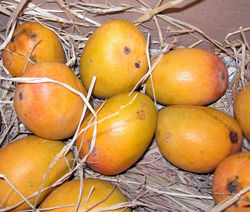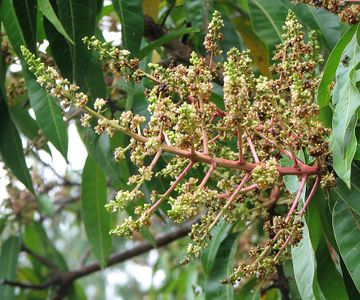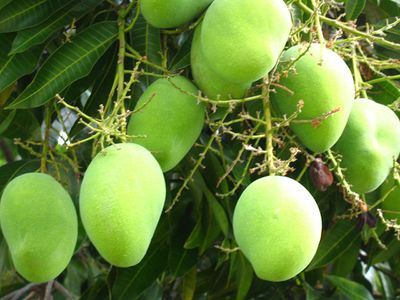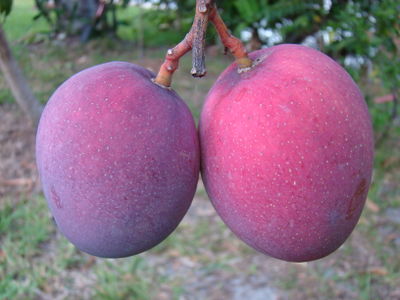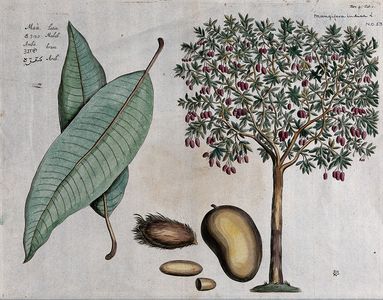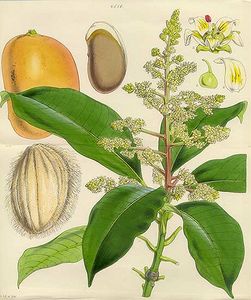Mangifera indica
Mangifera indica L.
| Order | Sapindales |
|---|---|
| Family | Anacardiaceae |
| Genus | Mangifera |
2n = 40
Origin : northern India, Burma
wild or cultivated
| English | mango |
|---|---|
| French | mango / mango |
- fruit eaten ripe or green
- fruit transformed into juice, chutneys...
- seed oil: substitute for cocoa butter
- lumber, fuelwood
- medicinal: bark, leaves, fruits, flowers, root, resin
- ornamental
- leaves, fruit and by-products: fodder
- bark rich in tannin and resin: dye
Contents
Description
Popular names
| French | mango / mango |
| English | mango |
| German | Mango |
| Dutch | mango |
| Italian | mango |
| Spanish | mango |
| Portuguese | mangueira / manga |
| Hindi | ām |
| Malayalam | Mānga |
| Guyanese Creole | mango [mang], mango foot [pjé-mang] (Pharma. Guyana) |
| wayãpi | mã (Pharma. Guyana) |
| palikur | mã (Pharma. Guyana) |
Classification
Mangifera indica L. (1753)
Cultivars
History
Michał Boym, 1656. Flora Sinensis
mau, Rheede, Hortus Malabaricus , vol. 4: 1-4, tab. 1
Uses
One of the most important and most delicious tropical fruits. Cultivated in India obviously since more than 4.000 years; now in more than 1.000 cultivars (mostly clones) in all countries of the tropics. Largest areas of cultivation are in India (60% of the fruit tree area), Indonesia, Philippines, USA (Florida, Hawaii), Mexico, Brazil, S and E Africa, Australia. The juicy and sweet ripe fruits are used as table fruit, for making juice, tarts, jams, jellies, ice-cream and preserves; unripe fruits are used in pickles and chutneys. They are rich in vitamin A and C. Fruits, leaves, flowers, roots, bark and resin have a medicinal importance. The bark contains 78% resin and 17% tannic acid and serves to dye yellow cotton, wool and silk. Domestication took place in India, the tree was distributed already BC eastwards, but much later to E and W Africa; from here it was introduced into tropical America (firstly grown in the West Indies). Human selection favoured succulence, low fibre and resin content of the fruits and small stones. Often un-improved seedlings are grown, but more recently mostly selected vegetatively propagated clones. Breeding work began in India in the early 20th cent.
References
- Bekele-Tesemma, Azene, 2007. Useful trees and shrubs for Ethiopia. Identification, propagation and management for 17 agroclimatic zones. Nairobi, ICRAF - RELMA. 550 p. (Technical Manual 6). See the article
- Boym, Michał, 1696. Flora Sinensis. Paris, 15 p. Second edition in French. See Manko on Pl@ntUse.
- Chauvet, Michel, 2018. Encyclopédie des plantes alimentaires. Paris, Belin. 880 p. (p. 54)
- Elevitch, Craig (ed.), 2006. Traditional Trees of Pacific Islands: their culture, environment, and use . Holualoa, Hawai'i, Permanent Agriculture Resources. 816 p. Agroforestry download pdf
- Grenand, Pierre, Moretti, Christian, Jacquemin, Henri & Prévost, Marie-Françoise, 2004. Pharmacopées traditionnelles en Guyane. Créoles, Wayãpi, Palikur. 2e édition revue et complétée. Paris, IRD. 816 p. (1ère éd.: 1987). See on Pl@ntUse.
- Rollet, Bernard et coll., 2010. Arbres des Petites Antilles. Tome 1 : Introduction à la dendrologie. 276 p. Tome 2 : Description des espèces. 866 p. + 46 pl. coul. + CD de photos sur l'anatomie du bois. Basse-Terre, ONF. on Pl@ntUse.
- TRAMIL, Pharmacopée végétale caribéenne, ed. scient. L. Germosén-Robineau. 2014. 3rd ed. Santo Domingo, Canopé de Guadeloupe. 420 p. See on Pl@ntUse
